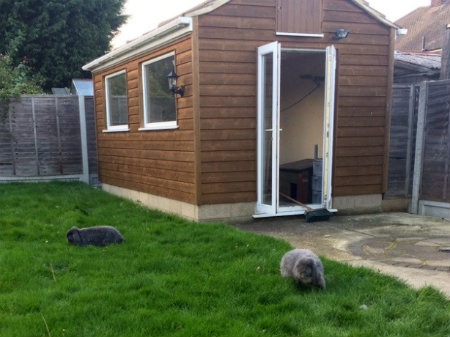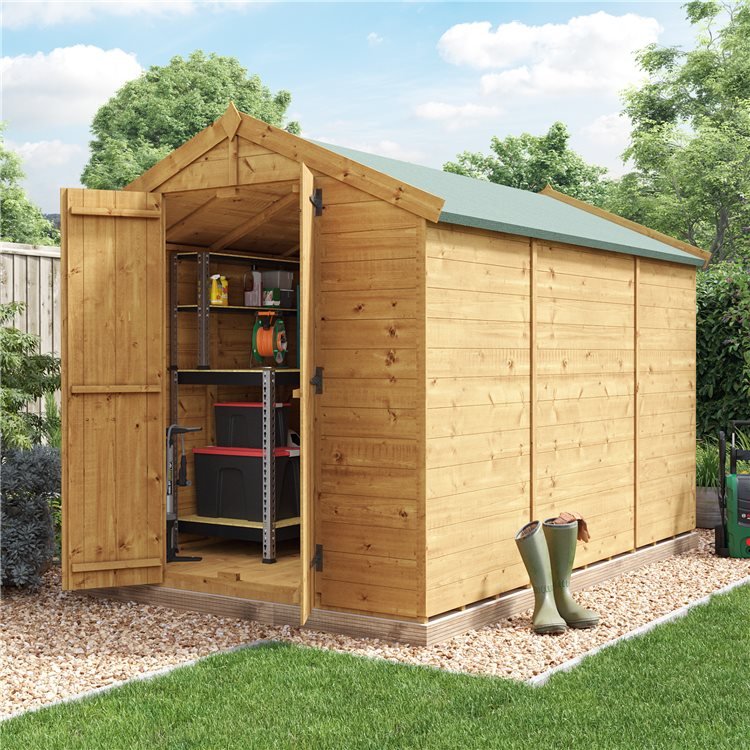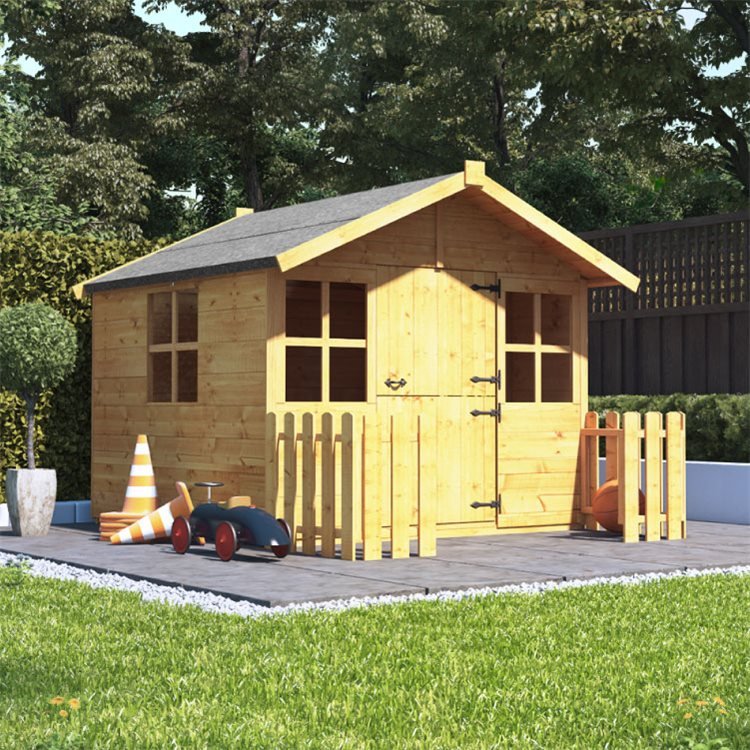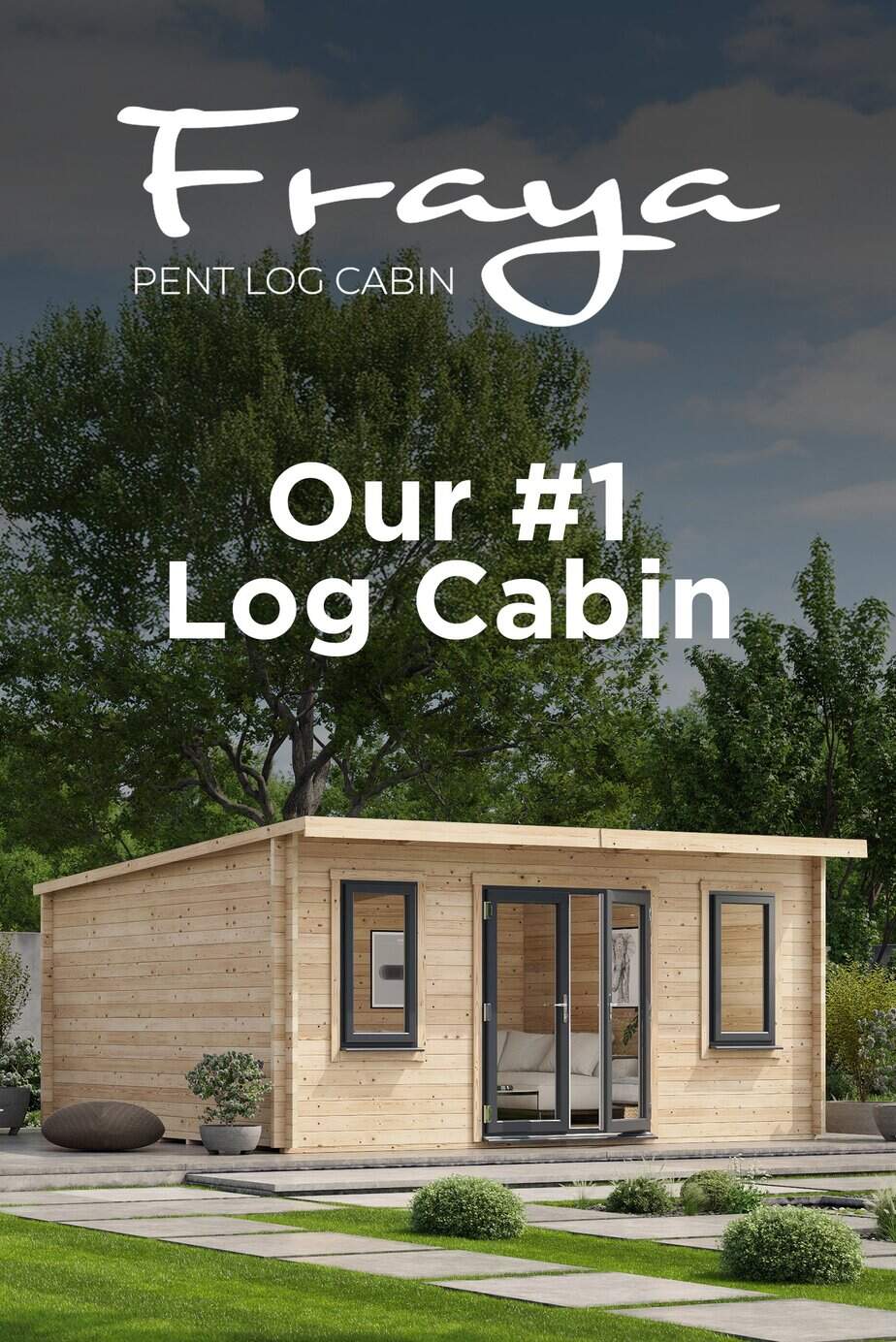
Image Credit: Nennieinszweidrei / Pixabay
Rabbits can be misunderstood pets, with different “experts” sharing differing advice. When it comes to their habitat, many pet shops sell small and unsuitable cages, leading to rabbits being chucked outside, and confined to a tiny crate. According to the Rabbit Welfare Association & Fund (RWAF) a hutch alone is not enough.
Rabbits require a large amount of space, a minimum of 3m x 2m x 1m for 2 average-sized rabbits. If your shed is smaller than 3m x 2m your rabbits will also require the addition of a permanent exercise run. Therefore, if you’re thinking about buying a rabbit, RWAF recommends converting a shed or playhouse into a dream house for your furry friends.
 Image Credit: Wabbitwiki CC BY-SA 3.0
Image Credit: Wabbitwiki CC BY-SA 3.0
Benefits of using a garden shed for a rabbit house
There are many benefits to using a garden shed to convert into a bunny house, these include:
- Your bunnies can live a happy life with plenty of space to run, jump and enjoy
- It gives your old garden shed or playhouse a purpose again
- Easier to clean out in the winter than a standalone hutch
- It’s easy to do and can last a lifetime for a bunny
Types of Shed to use
As with any shed conversion, there will be a lot of work upfront, however, once the conversion is done, you will have peace of mind knowing your rabbits can live happily in a space where they feel comfortable.
However, whether you are buying a new shed or converting an old one, there are requirements you need to follow.
Materials to use (and not to use)
- Do not use a metal shed as these can get hot in the summer and overheat easily, as well as the lack of ventilation in them.
- Avoid plastic playhouses as they will not be secure enough from other animals or protect against different weather conditions
- A wooden shed makes for a perfect rabbit home; however, some changes need to be made before putting your rabbits in the shed. This includes reinforcing the boards in the shed to stop bunnies from getting out and other animals from getting in.
Where to Start?
First things first you need to decide which shed you are going to use, whether you’re looking to purchase a new one from Garden Buildings Direct or refurb one you already have, the process is similar. However, if you are using an old shed, you will need to make sure it is still in good shape. If you are using a new shed, you can get straight on to the conversion.
If you are looking to purchase a shed for the project, the bigger the better. Some great choices for this are:

1.BillyOh Keeper Overlap Apex Shed
The BillyOh Keeper shed is an ideal shed for this project, as it comes in a variety of sizes. Depending on space and budget, buying one of the larger Apex sheds provides your rabbits with extra room to roam free and express themselves.
This shed comes can have added windows which is crucial for a rabbit. As stated by Rabbit Care Box ‘Rabbits do not have any tool to understand the time of the year. They use natural light to know the time’ without this they may feel lost.
2. BillyOh Expert Tongue and Groove corner shed
If you have a smaller garden this corner shed may be great as it slots into the corner but does not compromise on space. Although these sheds are nice looking on the outside, they will require extra customisation for the shed to make sure that it fits their needs. f
3. Master Tongue and Groove shed
If space isn’t an issue in your garden, you may want to consider the Master shed, with the size of this shed going up to 12×8, your rabbits can have the ultimate living quarters. Although this shed comes in large sizes, you can also opt for a smaller size of this classic-looking shed.
Alternatively, if you are looking to convert a playhouse, here are some suitable options-
4. Gingerbread Junior Playhouse
A great pick if you are choosing to convert a playhouse, one of the best features of a playhouse over a shed is the door. Most playhouses have a door which splits in two, allowing you to feed your rabbits without them escaping via the bottom door.
This playhouse is a decent size, with windows, however, you will need to cover these with a protective covering as these are open.

5. Lollipop Junior Playhouse
The Lollipop junior playhouse offers a lot of similar qualities and features to the gingerbread one, however, this one has styrene windows, which are shatterproof. This is great as it provides an extra element of warmth in the colder months.
When you’ve decided on your shed, it’s time to decide the location, it’s important to consider what your shed will be on. A great suggestion is paving slabs or a deck.
Now you’ve decided on the shed you are going to use and the location of the shed, it is important to start renovating it to make sure it is secure, easy to clean and safe for your rabbits to live in.
What you need in your Rabbit Shed
Before your bunnies move into their new home, it is important to do some modifications in order to make the shed a safe place for your rabbits to live.
Flooring
Although your shed will have wooden flooring, rabbits can often make a mess on the floor, which can eventually lead to the wood rotting. Putting lino down on top of the wood not only makes it easier for you to clean them out but also will preserve the wood, you can grab a roll of lino for a lot cheaper than replacing the whole shed floor!
Hutch or Hideout
Even though the rabbits have the shed to themselves, they enjoy going into places where they’re hidden as they feel safer there. As well as, having a hutch provides extra warmth when it is cold, as rabbits love to snuggle somewhere cosy.
Ventilation Holes
Even during the winter, ventilation holes are an important part of a converted shed. Pets4Homes advise that drilling up high on the walls creates good airflow.
Insulate Shed Walls
As a rabbit owner, you likely know that rabbits love nothing more than to chew on wood, therefore making sure you insulate the walls on the inside to protect them from being nibbled is super important.
You can use wallpaper, which is used in bathrooms as a solution, or alternatively double panel the walls, that way if the inside gets chewed, there’s an extra layer which can easily be replaced.
TOP TIP:
You may want to consider a litter tray or two in their shed as rabbit owners know too well how often rabbits use the toilet, a litter tray makes it a lot easier to clean them out.
Escape and Intruder Proofing
Unfortunately, animals such as foxes and rats are rife around outdoor rabbits, so making sure these animals can’t find a way inside the converted shed or exercise area is so important for their safety.
Attaching a Run
This is optional if your shed is bigger than 3m x 2m, however, if it is a smaller space than this, it is required. Rabbits require this space to be happy and healthy. They need to be able to run around and express themselves.
It is important to note you will need to take extra measures to protect the run from unwanted visitors, and to stop your rabbits from digging their way out.
If your shed is on grass, like putting the shed on a raised platform, raising the run is one of the best ways to protect your buns. If it is on a concrete base, there is no way of your rabbits digging under it to get out.
However, if your shed is already on paving this is likely to be secure enough to stop anyone digging underneath.
Don’t use Chicken Wire
Sadly, this mistake is often used when creating a run for rabbits and can have devastating consequences. Chicken wire is known for being flimsy and easy to bite through. Find an alternative such as a welded mesh of a heavy gauge, the thicker the better.
Wire Sizing
Although you may be able to keep foxes out with mesh, it is important to consider the size of the holes in the wire throughout any part of your enclosure, as other animals are dangerous to rabbits, which are considerably smaller than foxes.
The minimum thickness for the wire is 1.2mm, however, aiming for thicker is better as it’s more secure. Regarding the sizing in the holes, 13mm is the perfect size to stop smaller animals such as stoats, weasels, and polecats from getting into the enclosure.
Attach thick Wire to the Wood
When attaching the wire to the wood it is essential to make sure this is secure and that there are no gaps. Using heavy-duty staples to attach the wire to the wood is one of the best ways to make sure it is secure.
Provide a way for your Bunnies to access the Run
Ideally, your rabbits will have 24/7 access to their run, so making sure the run is easily accessible to your bunnies is important. However, on a converted shed, you need to consider how to make a safe way for them to get into the run.
Owners have been known to get a cat flap fitted, to allow their buns to get out easily. One of the perks of getting a cat flap is you can lock it shut if you ever need to, during times of bad weather such as storms.
Conclusion
Whether you’re a new bunny owner or looking to become one, it is important to create a space where they feel safe and happy. Therefore, converting a shed or outdoor playhouse is the ideal solution.
If you have indoor rabbits and you are looking to convert them to being outside in a shed conversion it is important to do it gradually as the change in temperature can be dangerous.
If you have converted your shed or playhouse, we’d love to see your creations!

